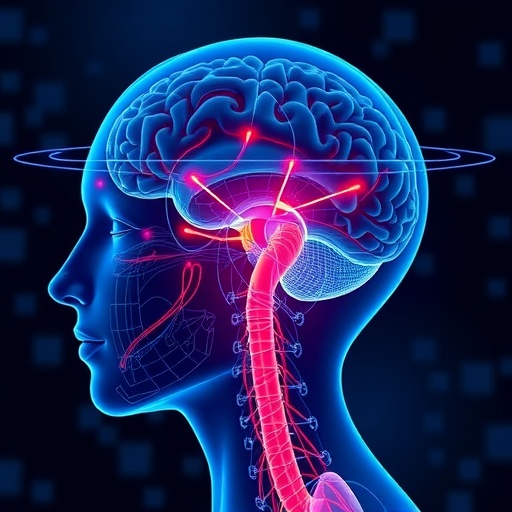In a groundbreaking study published recently in PLOS Biology, researchers from the University of Michigan’s Kresge Hearing Research Institute and the University of Rochester have shed new light on the complex neural mechanisms underpinning our ability to focus on individual voices amidst a cacophony of noise, a phenomenon often referred to as the “cocktail party effect.” Their findings fundamentally challenge earlier assumptions about the role of subcortical auditory processing in selective attention, providing compelling evidence that such selective filtering primarily occurs within the auditory cortex rather than the lower-level auditory brain structures.
Selective attention—the brain’s faculty to hone in on particular sounds while disregarding others—is well-documented to engage the auditory cortex. Previous investigations into this subject yielded ambiguous conclusions regarding whether subcortical regions like the auditory nerve or brainstem contribute to this filtering process. These brain areas are responsible for the initial stages of auditory processing, receiving raw signals from the cochlea and relaying them forward. The critical question this research addresses is whether these early auditory stations modulate their responses based on where attention is focused.
To tackle this problem, the research team implemented advanced and novel experimental methodologies, uniquely capable of discerning neural signals from different hierarchical levels of the auditory pathway simultaneously. Subjects participated in listening tasks involving two different audiobook narrations presented either diotically (both ears receiving the same sound mixture) or dichotically (each ear receiving a different audiobook). This realistic approach ensured that the auditory scene more closely mimicked everyday listening environments compared to previous studies relying heavily on synthetic or simplistic auditory stimuli.
Electrophysiological recordings captured neural responses from the auditory nerve, brainstem, and cortex. Remarkably, analyses revealed no observable differences in subcortical responses to attended versus unattended speech streams. This was the case regardless of whether listeners received identical stimuli in both ears or entirely different stimuli in each ear, indicating that subcortical structures processed all incoming speech signals without attentional bias. In stark contrast, cortical activity exhibited robust modulation when participants focused their attention on one speaker, amplifying the neural representation of the attended voice.
These results starkly diverge from certain prior studies suggesting subcortical involvement in selective attention, prompting the researchers to scrutinize methodological differences closely. One key distinction identified was the prior use of multiple stories from the same narrator, potentially confounding results through uncontrolled acoustic variability rather than true attentional effects. A supplementary experiment conducted within this research confirmed that such design choices could artificially inflate apparent subcortical attention effects.
While the study found no measurable subcortical attention modulation using current technologies, the authors caution against interpreting this as definitive proof of non-involvement. It remains plausible that sparse neuronal populations within the auditory nerve or brainstem might indeed contribute to selective attention but remain undetectable by present-day recording techniques. Further technological advancements might one day elucidate these subtle contributions.
Dr. Ross Maddox, the study’s senior author from the University of Michigan, emphasized the importance of their findings as a step forward in the ongoing quest to unravel the auditory system’s intricate computations: “Our experiments demonstrate that the human auditory brainstem response to natural speech is unaffected by selective attention, contrasting with cortical responses which are markedly modulated.” He noted that the new experimental paradigms developed for this study are instrumental in resolving long-standing debates in auditory neuroscience.
This research has significant implications for our understanding of human speech perception, especially in everyday noisy environments. By clarifying that selective attention mechanisms are predominantly cortical, therapeutic and technological interventions such as hearing aids or brain-computer interfaces might better target cortical activity patterns to improve speech intelligibility for individuals with hearing impairments in challenging acoustic settings.
Moreover, the findings highlight the auditory system’s hierarchical nature, where peripheral and subcortical structures faithfully encode acoustic signals without filtering, reserving the selective amplification and priority assignment to the cortex. This architecture likely reflects the evolutionary balance between rapid faithful transmission of sound information and the flexible, context-dependent processing essential for human communication.
The study’s methodological innovations, particularly the sophisticated measurement of simultaneous neural signals from multiple auditory levels, pave the way for future research probing other cognitive functions and sensory modalities. Continued interdisciplinary efforts integrating neurophysiology, cognitive psychology, and computational modeling will be crucial in revealing how complex auditory scenes are parsed by the human brain.
In summary, this research marks a pivotal advance in hearing science, resolving critical controversies on where selective attention operates within the auditory pathway. It underscores the dominance of cortical processes in managing focus within noisy environments while inviting further exploration into subtle subcortical roles that may yet be uncovered through next-generation neuroscience tools.
Subject of Research: People
Article Title: The auditory brainstem response to natural speech is not affected by selective attention
News Publication Date: 6-Oct-2025
Web References:
– https://journals.plos.org/plosbiology/article?id=10.1371/journal.pbio.3003407
– DOI: 10.1371/journal.pbio.3003407
Keywords: Selective attention, Cognition, Auditory perception, Speech perception
Tags: advanced experimental methodologies in neuroscienceauditory attention mechanismsauditory cortex and selective attentionauditory nerve and brainstem functionscocktail party effectcomplex neural processing of soundgroundbreaking research in auditory scienceindividual voices in noisy environmentsneural mechanisms of sound focusabilityselective filtering in auditory perceptionsubcortical auditory processingUniversity of Michigan Kresge Hearing Research Institute





